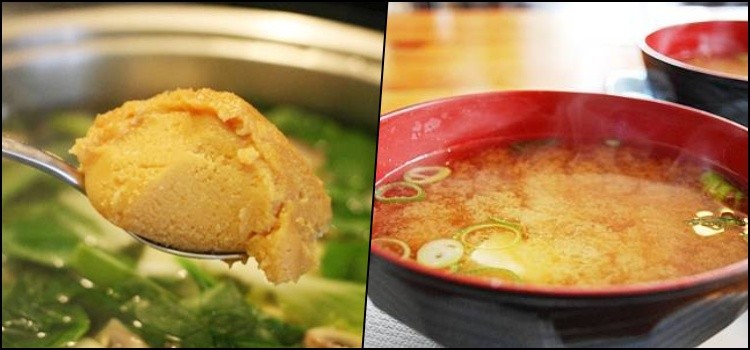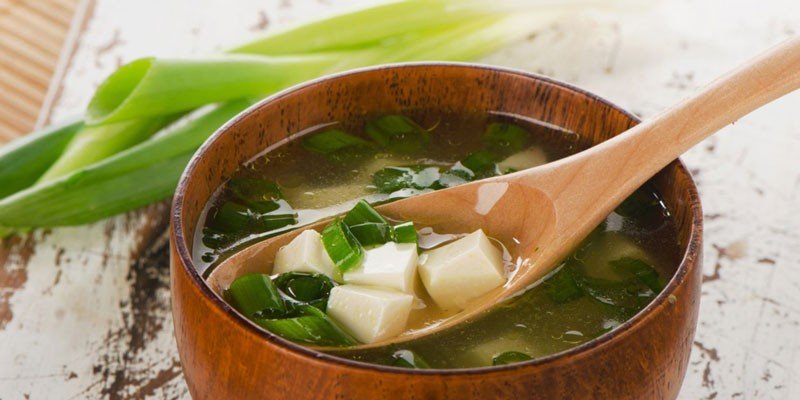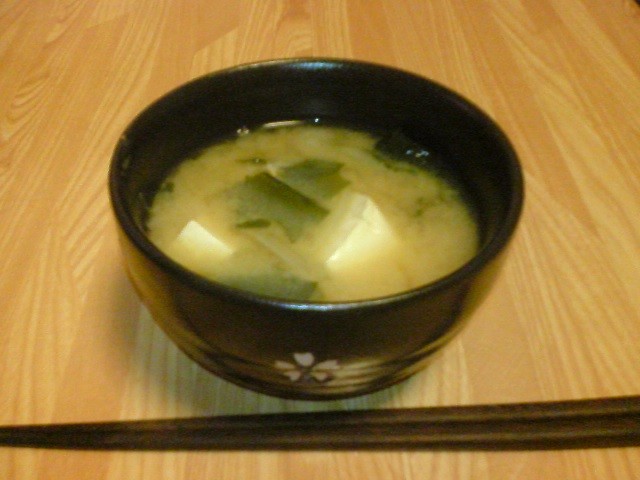Have you ever imagined waking up early and having that soup before work? Considering Brazilian customs, I think it's hard to happen. But in Japan, we have the traditional miso or misoshiru [味噌汁]. It is present on the table of all Japanese people, the miso soup can be consumed any time of the day - even at breakfast.
It is believed that miso originated in China and Korea, with records of its use dating back to the year 901 in the Heian Era. This soup is rich in vitamins and is one of the reasons for maintaining the longevity of the Japanese and their youthful appearance.
Miso is full of protein, carbohydrates, calcium, vitamins B2, B12, and E as well as enzymes that aid digestion and other nutrients found in soy.
Table of Content
Main ingredients of miso soup
Two ingredients are essential to make a miso soup: dashi and miso. But what are they?
The dashi, basically speaking, is all the liquid part of a broth. This is because only the liquid from the broth with flavor is used. There are no pieces. It can be made by cooking meats, fish bones, or chicken that are not used in main dishes, along with vegetables, herbs, and seaweeds. Not all these or other ingredients are always used.
But when you want a thicker and richer flavored dashi, meat and bones are essential. It is through the cooking of the bones that collagen is extracted, which gives the dashi a firm appearance. You can make your own dashi, but powdered dashi is easily found.

The miso is made from fermented soybeans. The fermentation of soybeans is achieved through the fungus Aspergillus oryzae or 麹菌, kōji-kin, which is also used in almost every fermentation process in Japan, including sake. Even though it is the main ingredient of miso, soybeans are almost always accompanied by other grains, such as rice and barley, for example.
The texture, flavor, and color of misso are almost always defined by the fermentation time. The longer the fermentation time, the firmer the misso becomes, with a stronger flavor and color as well.
Miso or Miso? - The term in Japanese is written without elongation, with only one S, but to facilitate the pronunciation in English, we sometimes find it written with two SS. O misoshiru is a Japanese word, while missoshiro is a word adapted to Portuguese.
Solid Miso Soup Ingredients
Now that you know the ingredients that define miso soup, let your imagination run wild. That's right. The other ingredients are at the discretion of the cook. In Japan, ingredients are chosen according to the season and almost always have some form of contrast.
For example, often tofu is mixed with negi, one with a mild aroma and the other with a strong aroma. Another example of contrast is ingredients that float, like wakame seaweed, and ingredients that sink, like potatoes.
Other ingredients commonly used are: daikon slices, potatoes, seaweed, onion, mushrooms, clams, shrimp, and fish. However, if you add pork to the soup, it ceases to be missoshiru and becomes tonjiru, pork soup.

Different types of Misoshiro
There is not just one type of soy miso soup, most can contain different amounts of soy and other ingredients like rice. Or they can simply be composed of other ingredients. This will affect the color of the paste in the soup.
The way to prepare misoshiro also affects the name of the recipe. For example, if you prepare miso with pork, it can become the famous tonjiro or butajiro. This paste is also commonly used in the creation of other recipes and in ramen.
Barley Miso [麦味噌]
Mugi [麦] is the generic term for wheat, but in terms of miso it mainly refers to barley. Mugi-miso [麦味噌] or barley miso is a whitish miso that is produced in the areas of Kyushu, western Chugoku, and Shikoku. Another reddish mugi-miso is produced in the northern area of Kanto.
Rice Miso [米味噌]
Bei [米] is the word used for raw rice. O bei miso or kome-miso is miso with rice, it can come in a variety of colors, including yellow, yellowish white, and red. Kome miso is mostly consumed in eastern Japan and in the Hokuriku and Kinki areas.
Soy miso [豆]
The word mame [豆] is a generic term for grains, but in terms of miso, it refers to soybean miso. Mame miso is dark brown, more reddish than kome miso. It is usually not as sweet as the other two, but has some astringency and good umami flavor [旨味].
This mame miso requires a long period of maturation. Mame miso is mainly produced and consumed in Aichi Prefecture, part of Gifu Prefecture and part of Mie Prefecture.

Where to Buy Miso Paste?
Misoshiro can be purchased at markets with oriental products or on the internet. We will leave below an online store where you can find a one kilo pot of miso for a very cheap price. Of course there are different brands.
Recently, I bought a pot of Missô Shiro and Missô Akai from Sakura. The akai is more red and stronger, while the standard one has more rice in its composition, which makes it less strong. I liked it a lot and was able to make ramen and other recipes.
In addition to the miso paste, you will need the fish broth, which is sold in Brazil under the name Hondashi. Unfortunately, I only found the professional size, which can be a bit pricey, but for the amount I think it's worth it.
In addition to the miso paste, we leave a ready-to-make misoshiro (I don't know if it's as delicious as freshly made) and also the Wakame seaweed. You can use chives or invent with other ingredients to diversify the soup.

How to prepare and serve misoshiru
Regardless of whether you choose to make your own dashi or buy it in powder form, a technique always used is to boil the solid ingredients in the dashi. But never boil the miso, if you do so it's as if you were preparing a ramen.
This alters the flavor of miso, reduces its health benefits, and kills beneficial bacteria for the body. After cooking vegetables and meat in dashi, remove the broth from the heat, add the miso and the other uncooked ingredients, and it's ready. Now just serve.
Miso soup is usually served in lacquered bowls. This makes it easier to drink the broth directly from the bowl and eat the other ingredients with hashi. If you prefer, use bowls with lids for serving. They help to preserve the aroma and heat, as well as provide a beautiful presentation of the dish if you want to impress someone.
I decided not to put any recipes, because they are easily found on the internet and also because with the main ingredients each one can create their own miso soup variant. If you liked it, please share.

Missoshiro's Poem
There is a Japanese Poem written by Daizaburo Nakayama that describes the usefulness of miso well. Let's end the article with this poem below, starting with the translated version, then with the lyrics in Japanese:
In winter, it's cold, so you have a good miso soup.
A sweet miso soup.
This is the taste of my mother
The soup took care of everyone
After my mother became an adult,
That's why I look like this every time I drink hot miso soup
It's because I remember mom.
Don't forget about me, mom.
You were also born in Tohoku.
I know how you feel, but I prefer not to…
A woman who loves such hot miso soup.
What is pottage after all?!
Sleeping on the futon in my underwear
I'm not saying it's rice.
Field rice? If you are going to build something, then Iwate Prefecture is a good place to start.
Blonde? I think blonde hair is nice.
Still, people have forgotten something these days.
Are the Japanese the same?
Some Japanese forget their birthplace and miso soup.
I wonder more if the world is angry or if it is just sad.
Where has all this gone, filial duty, like humanity, just paper balloons
It has been 16 years since I left home.
I dreamed of miso soup and every time I remembered it,
my childhood heart starts to ache.
I can't help but cry as I think about it tonight.
I don't know if it's going to snow or not.
But I really want to wish I could eat my mother's miso soup again…!
Japanese Version of the Poem
味噌汁の詩
千 昌夫 歌
中山 大三郎 作詞/作曲
(セリフ)しばれるねぇ 冬は寒いから味噌汁がうまいんだよね
うまい味噌汁 あったかい味噌汁
これがおふくろの味なんだねえ
あの人 この人 大臣だってみんないるのさ
おふくろが いつか大人になった時
なぜかえらそな顔するが あつい味噌汁 飲む度に
思い出すのさ おふくろを
わすれちゃならねえ 男意気
(セリフ)へぇーそうか おまえさんも東北の生まれか
気持ちはわかるが あせらねえ方がいいな
やめろ!あんなあまったるいもの好きな女なんか
何がポタージュだい 味噌汁の好きな女じゃなくちゃ!!
寝るのはふとん 下着はふんどし ごはんのことを
ライスだなんて言うんじゃないよ。
田園調布? 家を建てるんなら岩手県 それも陸前高田がいいね
金髪? き・・・金髪だけはいいんじゃないべかねえ
それにしても近頃の人は 何か忘れてるね
これでも日本人なんだべかねぇ
日本人なら忘れちゃこまる 生まれ故郷と味噌汁を
何だかんだと世の中は 腹が立つやら 泣けるやら
どこへいたか親孝行 まるで人情 紙風船 忘れちゃならねぇ 男意気
(セリフ)ふるさと出てから16年 いつもおふくろさんの
ふところ夢見ておりました 思い出すたびに
子の胸がキューッと痛くなるんです
思わず涙が出てくるんだなあ それにしても今夜はしばれるねぇ
このぶんだと雪になるんでねえべか
おふくろさんの味噌汁が食いたいなあ・・・かあちゃーん!!